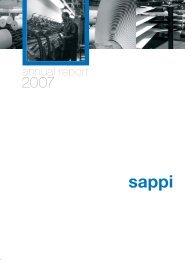2012 Integrated report - Sappi
2012 Integrated report - Sappi
2012 Integrated report - Sappi
Create successful ePaper yourself
Turn your PDF publications into a flip-book with our unique Google optimized e-Paper software.
4<br />
electricity<br />
steam<br />
black liquor<br />
pulp mill<br />
white liquor<br />
chemical recovery<br />
5<br />
manufacturing operations<br />
electricity<br />
steam<br />
CO 2 by-product<br />
(released into atmosphere)<br />
pulp and<br />
paper products<br />
dissolving<br />
wood pulp mill<br />
landfill<br />
7<br />
6<br />
distribution centre/<br />
converters<br />
printers<br />
paper collection<br />
specialised cellulosic textiles<br />
and non-woven fibre products<br />
4<br />
continued<br />
5<br />
6 7<br />
Water<br />
Globally, we return approximately<br />
92% of process water to the<br />
environment. Over five years our<br />
specific water usage has<br />
decreased by 10.5%.<br />
Transportation<br />
Throughout our operations we<br />
are focused on streamlining our<br />
transport processes. For further<br />
information go to our regional<br />
sustainability <strong>report</strong>s or our group<br />
online <strong>report</strong> available at<br />
www.sappi.com.<br />
Carbon dioxide<br />
Our focus is on reducing our<br />
carbon footprint by improving<br />
energy use efficiency and<br />
decreasing our reliance on fossil<br />
fuels. We are achieving this<br />
by making process changes,<br />
installing more efficient equipment,<br />
reducing purchased energy<br />
(electricity and fossil fuel) and by<br />
increasing our use of renewable<br />
energy – an approach that<br />
ultimately results in a reduction in<br />
CO2 emissions. Globally, over five<br />
years, Scope 1 (direct) and 2<br />
(indirect) CO2 emissions have<br />
dropped by 18.5%.<br />
Our customers<br />
Paper is transported to regional<br />
distribution centres, merchants<br />
and printers. Designers specify<br />
paper which printers convert<br />
into products such as books,<br />
magazines, brochures, bags<br />
and labels. The dissolving wood<br />
pulp we produce at Saiccor Mill<br />
accounts for 15% of global<br />
demand and is exported from<br />
South Africa to markets mostly<br />
in Asia and Europe. We will<br />
increase capacity by 63% in<br />
2013. Our dissolving wood pulp<br />
is used in the manufacture of<br />
cellulosic textiles and non-woven<br />
fibre products used in the fashion,<br />
pharmaceutical and consumer<br />
markets.<br />
Landfill<br />
Decomposition of organic<br />
materials in landfills can generate<br />
methane, a greenhouse gas with<br />
a global warming potential of<br />
approximately 25 times higher<br />
than CO2. Recovering and<br />
recycling paper and board helps<br />
to minimise the emissions<br />
associated with landfill. Over five<br />
years the amount of solid waste<br />
we send to landfill offsite has<br />
decreased by 31.4%.<br />
sappi <strong>Integrated</strong> Report <strong>2012</strong> 17
















